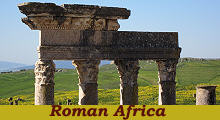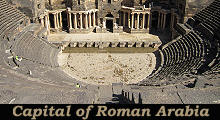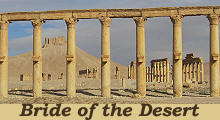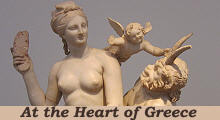  What's New! Detailed Sitemap All images © by Roberto Piperno, owner of the domain. Write to romapip@quipo.it. Text edited by Rosamie Moore. Page added in July 2012. |
 - Thuburbo Majus - Thuburbo Majus(detail of the theatre at Thugga) In 1857 French diplomat Charles-Joseph Tissot came to the conclusion that the ruins he visited at Henchir al-Kasbat, thirty miles south of Tunis, were those of Thuburbo Majus. Henchir is an Arabic word meaning "farm with ruins" and the discovery of seven ancient Roman towns was facilitated by their ruins being referred to as henchir. The 1895 Murray's Handbook for travellers in Algeria and Tunisia made reference to Thuburbo Minus, an ancient Roman town in the Mejerda River valley, but ignored the existence of Thuburbo Majus, because at the time the site was yet to be excavated.
Archaeological excavations started in 1912; they led to the identification of the Forum and of some large houses decorated with mosaics. Other excavation campaigns were carried out in the 1930s and 1950s, but still a large part of Thuburbo Majus is yet to be freed from the impact of centuries of abandonment.
Unlike those of Thugga, the monuments of Thuburbo Majus collapsed and archaeologists were not immediately able to assess the level of wealth achieved by the town, although the fact that it was referred to as Majus (major) was per sŤ an indication of its importance. The mosaics found in the houses provided the archaeologists with the answer they were looking for. They could compete with those found at Carthage and at Utica, the largest cities of Africa, as the Romans called today's Tunisia.
The archaeological area is adjoined by farms and there is not a fence between the two. It is not unusual to see shepherds leading their flocks to graze in the areas surrounding the ancient monuments as shown in the image in the introductory page of this section. In spring wild flowers and green meadows are a pleasant frame for the ancient ruins, but in other seasons they may add to the feeling that the archaeological area is not properly cared for.
The finest mosaics were moved to the Museum of Bardo in Tunis; the geometric ones were left in situ. The House of the Tied Animals retains a relatively rare example of black and white mosaics; these were very popular in Rome and Emperor Hadrian, a man who did not lack resources, decorated the Hospitalia, the rooms for his guests at Villa Adriana, with black and white mosaics. Probably the wealthy citizens of Roman Africa felt that coloured mosaics best expressed their social status.
During the Third Punic War Thuburbo sided with Carthage and the town was punished by the Romans who imposed a hefty yearly payment as a sign of submission. In 27 BC Emperor Augustus settled some of his veterans in the environs of the town. This led to the creation of two communities; one of peregrini (native freemen) who lived in the civitas (town) of Thuburbo and one of descendants of the veterans who had Roman citizenship and who lived in the pagus, a Roman word indicating a rural district. The two communities had different laws and local authorities, but over time these distinctions faded away. Emperor Hadrian visited Africa and he granted the status of municipium to the civitas of Thuburbo, thus giving more rights to its citizens. In 166 the inhabitants of both civitas and pagus erected a temple in the Forum which was dedicated to Jupiter, Juno and Minerva, the three deities who were worshipped in a great temple on the Capitolium hill in Rome. Public announcements were made from the high podium of the temple.
In 188 the process of integration of Thuburbo into the Roman government system was completed by Emperor Commodus who unified civitas and pagus into Colonia Julia Aurelia Commoda and granted Roman citizenship to all its inhabitants. Thuburbo enjoyed a period of great prosperity until the middle of the following century, then something happened which caused its decline. During the IVth century Emperor Constantius II tried to revive the town by restoring some of its public buildings. He renamed it Respublica Felix Thuburbo Majus.
Several temples of Thuburbo were turned into churches in the IVth century, but rifts among supporters of Donatism, a local Christian sect, and supporters of the official church controlled by the emperors probably caused a new decline of the town. Unlike what can be observed at Thugga, Sufetula, Mactaris, Mustis and other locations, there is no evidence of Byzantine fortifications, which indicates that when the Arabs invaded Roman Africa in the VIIth century, Thuburbo was just a village of peasants.
The Forum, the centre of the ancient town, was redesigned at the same time as the Capitolium. It was surrounded by a portico of cipollino columns, a green marble which came from Greece. These columns created a contrast with those of the Capitolium which were of a local pink stone to emphasize the importance of the building. The Forum was complemented by a market which included shops and a basilica, which probably housed a tribunal.
The economy of Thuburbo did not rely solely on farming. The town was located along an inland Roman road which linked Carthage with Algeria and it was therefore visited by merchants. Mercury was the god of trade and in 211 a temple was erected to him next to the Capitolium (the same occurred at Thugga). It had an unusual shape with a round peristyle inserted in a square space limited by four apses.
The area to the south-west of the Forum makes up the visitable part of the archaeological area and that where the most interesting buildings are located. The area on the other side of the Forum (behind the Curia) was a neighbourhood of workshops and small houses. Today apparently it seems yet to be excavated, but detailed archaeological maps published in the 1960s show that it has been investigated already.
The head of a gigantic statue of Jupiter was found in the Capitolium (it is now at the Museum of Bardo - external link). The archaeological site of Thuburbo Majus is not complemented by a small museum so reliefs, inscriptions and sections of lintels retaining a fine decoration are scattered here and there, not necessarily on the site where they were found.
At many Roman houses in Tunisia, archaeologists have found semicircular basins, usually located in the main courtyard of the building, which are therefore believed to have been fountains, but which at other locations such as at Bulla Regia were used for inside bathing. In most cases these fountains were decorated with heads of Oceanus surrounded by sea creatures as at Thuburbo Majus and at Neapolis.
The Labyrinth, the maze at Knossos where Theseus slayed the Minotaur was a popular decorative motif. Usually mosaicists, as at Mascaris (it opens in a separate window - left image), did not include the actual scene of the killing, which instead at Thuburbo was depicted in all its violence. Peltas, the crescent-shaped shields of the Amazons were another popular decorative motif for geometric mosaics. You can see them in the image used for the background of this page (House of Neptune).
Occasionally the subjects of the mosaics were meant to show the culture of the landlord and his literary tastes. One of the best known mosaics at the Museum of Bardo portrays Virgil in the act of writing the Aeneid (external link). A mosaic found at Thuburbo is believed to portray Menander, a Greek dramatist of the IIIrd century BC whose works were translated into Latin. Perhaps he was not portrayed for his plays, but for a series of maxims attributed to him, some of which are still popular today such as night brings counsel and bad company corrupts good morals (the latter was cited by St. Paul - Corinthians 15:33). Move to page two: the south-western monumental area of Thuburbo Move to: Introductory Page Bulla Regia Carthago Mactaris Musti Neapolis Sicca Veneria Simitthus Sufetula Thugga Thysdrus Uthina Utica Ziqua Mosaics in the Museum of Bardo    
|













